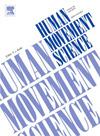Influence of wearing a head-mounted display on the movement execution of basic elements on the balance beam in women's artistic gymnastics
IF 1.9
3区 心理学
Q4 NEUROSCIENCES
引用次数: 0
Abstract
Virtual reality in artistic gymnastics has hardly been researched yet, but could have positive effects on learning movements, particularly on the balance beam, whose width and height demand significant effort. This study aimed to identify suitable gymnastics elements for the execution with a head-mounted display (HMD), considering potential performance impacts related to its size, weight, and limited field of view. Twelve basic elements covering the characteristics of the balance beam were performed by 36 competitive gymnasts (16.5 ± 6.6 years) on a low beam (10 cm) with and without the HTC VIVE Pro Eye HMD, which displayed the real environment through its cameras instead of a virtual one. A helmet with similar dimensions and weight to the HMD was used as a third condition to isolate vision effects. Licensed judges evaluated all trials for recognition and execution based on international scoring rules. Both analyses show that the performance was more impacted by restricted vision than by additional weight. Execution quality varied significantly between the condition with and without HMD for all movement characteristics, although the differences were smaller for jumps, holds/acrobatic non-flight elements and leaps than for elements with turns. Consistent with this, no significant differences in jumps and holds/acrobatic non-flight were found between the original and helmet conditions. In summary, elements without longitudinal axis rotations are well-suited for HMD execution, and results can be improved with better hardware and longer familiarization. Future studies should prioritize good optical resolution, a large field of view, and compact design over low weight when selecting HMDs.
头戴式显示器对女子艺术体操平衡木基本动作执行的影响。
虚拟现实技术在艺术体操中的应用研究还很少,但它可能对学习动作有积极的影响,特别是在平衡木上,它的宽度和高度都需要很大的努力。本研究旨在确定适合头戴式显示器(HMD)执行的体操元素,考虑其尺寸,重量和有限视野对性能的潜在影响。36名年龄(16.5±6.6岁)的竞技体操运动员在低梁(10厘米)上完成平衡木的12个基本动作,佩戴或不佩戴HTC VIVE Pro Eye HMD,该设备通过摄像头显示真实环境,而不是虚拟环境。与HMD尺寸和重量相似的头盔被用作隔离视觉效果的第三个条件。持牌裁判根据国际评分规则对所有试验的认可和执行情况进行评估。两项分析都表明,视力受限对视力的影响比体重增加对视力的影响更大。在有和没有HMD的条件下,执行质量在所有动作特征上都有显着差异,尽管跳跃、保持/杂技非飞行元素和跳跃的差异比有转身的元素要小。与此一致的是,在原始条件和头盔条件之间没有发现跳跃和保持/杂技非飞行的显著差异。总之,没有纵轴旋转的元素非常适合HMD执行,并且可以通过更好的硬件和更长的熟悉时间来改进结果。未来的研究在选择头显时应优先考虑良好的光学分辨率、大视场和紧凑的设计,而不是低重量。
本文章由计算机程序翻译,如有差异,请以英文原文为准。
求助全文
约1分钟内获得全文
求助全文
来源期刊

Human Movement Science
医学-神经科学
CiteScore
3.80
自引率
4.80%
发文量
89
审稿时长
42 days
期刊介绍:
Human Movement Science provides a medium for publishing disciplinary and multidisciplinary studies on human movement. It brings together psychological, biomechanical and neurophysiological research on the control, organization and learning of human movement, including the perceptual support of movement. The overarching goal of the journal is to publish articles that help advance theoretical understanding of the control and organization of human movement, as well as changes therein as a function of development, learning and rehabilitation. The nature of the research reported may vary from fundamental theoretical or empirical studies to more applied studies in the fields of, for example, sport, dance and rehabilitation with the proviso that all studies have a distinct theoretical bearing. Also, reviews and meta-studies advancing the understanding of human movement are welcome.
These aims and scope imply that purely descriptive studies are not acceptable, while methodological articles are only acceptable if the methodology in question opens up new vistas in understanding the control and organization of human movement. The same holds for articles on exercise physiology, which in general are not supported, unless they speak to the control and organization of human movement. In general, it is required that the theoretical message of articles published in Human Movement Science is, to a certain extent, innovative and not dismissible as just "more of the same."
 求助内容:
求助内容: 应助结果提醒方式:
应助结果提醒方式:


